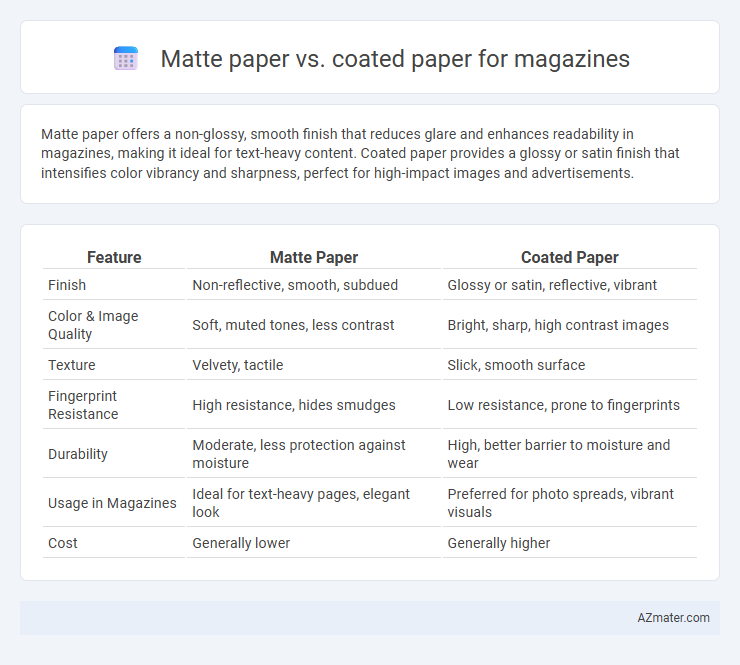Matte paper offers a non-glossy, smooth finish that reduces glare and enhances readability in magazines, making it ideal for text-heavy content. Coated paper provides a glossy or satin finish that intensifies color vibrancy and sharpness, perfect for high-impact images and advertisements.
Table of Comparison
| Feature | Matte Paper | Coated Paper |
|---|---|---|
| Finish | Non-reflective, smooth, subdued | Glossy or satin, reflective, vibrant |
| Color & Image Quality | Soft, muted tones, less contrast | Bright, sharp, high contrast images |
| Texture | Velvety, tactile | Slick, smooth surface |
| Fingerprint Resistance | High resistance, hides smudges | Low resistance, prone to fingerprints |
| Durability | Moderate, less protection against moisture | High, better barrier to moisture and wear |
| Usage in Magazines | Ideal for text-heavy pages, elegant look | Preferred for photo spreads, vibrant visuals |
| Cost | Generally lower | Generally higher |
Introduction to Magazine Paper Choices
Matte paper offers a non-reflective, smooth finish ideal for magazines emphasizing readability and muted colors, while coated paper provides a glossy or satin surface that enhances vibrant images and sharp text. Selecting between matte and coated paper affects print quality, durability, and overall aesthetic, influencing the magazine's visual impact and reader engagement. Understanding these paper types supports informed decisions for publishers aiming to balance cost, design, and audience experience.
What is Matte Paper?
Matte paper features a non-glossy, smooth finish that reduces glare, making it ideal for magazines emphasizing readability and subtle color tones. This type of paper absorbs ink differently, resulting in softer images and text that enhance visual comfort in long reading sessions. Matte paper's muted texture provides a sophisticated, elegant look favored in high-end magazine printing.
What is Coated Paper?
Coated paper features a smooth finish achieved by applying a surface layer of materials like clay or latex, enhancing brightness and color vibrancy in magazine printing. This coating reduces ink absorption, resulting in sharper images and more vivid photographs compared to matte paper. Its glossy or satin finish makes it ideal for high-quality visuals and detailed layouts commonly used in magazines.
Visual Differences: Matte vs Coated Paper
Matte paper offers a non-reflective surface that reduces glare, enhancing readability and providing a smooth, understated finish ideal for text-heavy magazines. Coated paper, often glossy or satin, produces vibrant colors and sharp image details due to its reflective surface, making it the preferred choice for photo-rich spreads. The visual difference lies in matte paper's muted tones and soft textures versus coated paper's bright, high-contrast images that catch the reader's eye.
Print Quality and Color Vibrancy
Matte paper offers a non-glossy finish that reduces glare and fingerprints, providing a smooth, subdued print quality ideal for magazines emphasizing text and subtle images. Coated paper, often glossy or semi-glossy, enhances color vibrancy and sharpness by reflecting more light, making photos and graphics appear more vivid and eye-catching. For magazines prioritizing striking visuals and dynamic color reproduction, coated paper generally delivers superior print quality compared to matte paper.
Texture and Tactile Experience
Matte paper offers a smooth, non-reflective surface that enhances readability and provides a soft, velvety tactile experience, making it ideal for magazines with sophisticated, understated aesthetics. Coated paper features a glossy or satin finish that delivers vibrant color reproduction and a slick texture, enriching images and making visuals stand out with sharp detail. The choice between matte and coated paper significantly impacts the magazine's feel, with matte producing a subtle, elegant touch and coated offering a sleek, polished sensation.
Durability and Longevity Considerations
Matte paper offers a soft, glare-free finish that resists fingerprints and minor scratches, enhancing the magazine's durability in everyday handling. Coated paper, typically glossy or satin, provides a protective layer that resists moisture and smudging, extending the magazine's longevity under frequent use. Both types ensure print quality retention, but coated paper's enhanced resistance to wear and environmental factors generally results in a longer lifespan for high-traffic publications.
Cost Comparison: Matte vs Coated Paper
Matte paper generally costs less than coated paper due to its simpler manufacturing process and lower gloss finish. Coated paper, often featuring a glossy or semi-gloss surface, requires additional coatings and treatments that increase production expenses and retail price. For magazines, choosing matte paper can reduce overall printing costs while coated paper offers enhanced visual appeal at a higher price point.
Best Use Cases for Each Paper Type
Matte paper is ideal for magazines featuring text-heavy content, photography with subtle tones, or artistic illustrations due to its non-reflective finish that reduces glare and enhances readability. Coated paper, with its smooth, glossy or satin finish, is best suited for vibrant, high-contrast images and advertisements, providing sharp color reproduction and a polished look. Choosing between matte and coated paper depends on whether the magazine prioritizes visual impact with vivid colors or a sophisticated, muted aesthetic for more tactile content.
Choosing the Right Paper for Your Magazine
Matte paper offers a smooth, non-reflective finish that enhances readability and reduces glare, making it ideal for magazines with heavy text or artistic photography. Coated paper, typically gloss or satin, delivers vibrant colors and sharp image quality, perfect for magazines with high-impact visuals and advertisements. Selecting the right paper depends on your magazine's content style and target audience, balancing visual appeal with practical readability.

Infographic: Matte paper vs Coated paper for Magazine
 azmater.com
azmater.com